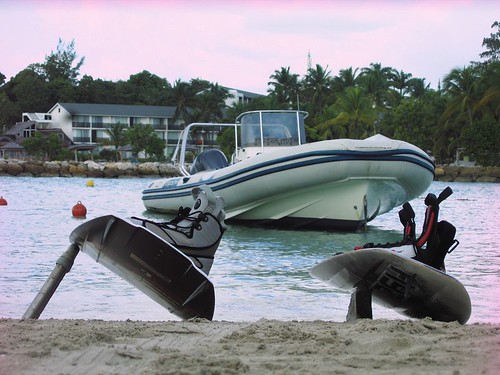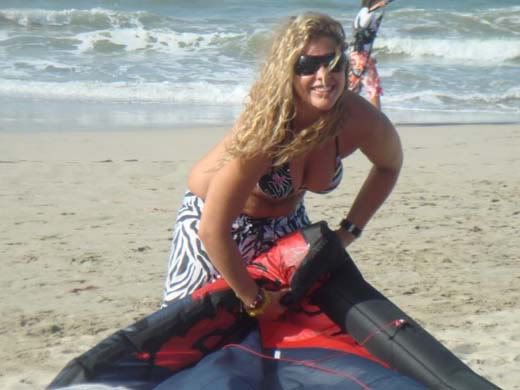Source(google.com.pk)
How To Kite Surfing Biography
Learning Progression
1 Land Lesson
"Ninety percent of kiteboarding is kite control," Markus Schale, owner of Kiteboarding School of Maui, says. Beach-based lessons allow beginners to practice with special training kites that have short, easy-to-control lines. The key is to keep an eye on the 180-degree arc in the sky that the kite flies in, called the "wind window."
2 Body Dragging
Before strapping on a board, you'll practice controlling the kite as it drags your body—face-first—through the water. Fly the kite close to the water while keeping your head down and legs together. This turns your torso into a rudder, dragging you upwind—an essential skill if you hope to retrieve a lost board. (Kiters don't use leashes; the slingshot effect can be skull-cracking.)
3 Water Start
Start out your run with the board pointed about 45 degrees downwind toward the kite—there will be less resistance than with a sideways board and it'll be easier to get up. While keeping the kite hovering at the neutral noon position, carefully slip your feet into the board's foot straps. Aim the board slightly downwind, and then dive the kite hard while driving your weight through your hips, legs and feet. Once you're standing upright, dive the kite again to accelerate and get your board planing. Now lean back at a 45-degree angle and, depending on which direction you're riding, park the kite at either the 11 o'clock or 2 o'clock position. "Keep your body in a straight line," Laurel Eastman, a former pro kiter, says. "Push your hips forward and shoulders to the sea."
4 Riding Upwind
Riding upwind returns you to the beach at the same spot you entered the water. To do this, fly the kite low and maintain even power. While edging against the kite, lean back, then swivel your hips and upper body in the direction you want to tack. Push down on your back foot to keep your edge from slipping down-wind. "Always look over your shoulder, facing where you want to end up," Schale says.
Beginning kiters will need to find a school to take lessons and rent equipment.
EAST COAST REAL Kiteboarding, Cape Hatteras, N.C.
GREAT LAKES Broneah Kiteboarding, Traverse City, Mich.
GULF COAST South Padre Island Kite-boarding, South Padre Island, Texas
WEST COAST Wind Over Water Kiteboarding, Burlingame, Calif.
The Skills
Fig. 1 Steering the Kite
To steer the kite, push forward with one hand while pulling back with the other—like your hands are exchanging punches. "The kites have a flexible structure, so when you're steering, you're actually twisting the entire membrane of the kite," says engineer and inventor Saul Griffith, who has designed kites for a number of companies. To dive the kite to the left, pull in with your left hand and push forward with your right. To steer right, do the opposite.
Fig. 2 Diving the Kite
To stand still, keep the kite flying in the noon position. To pull yourself forward, dive the kite toward the water before pulling it back up to the sky. "The kite acts like a wing, and diving it makes it move faster, which gives you exponentially more force," Griffith says. "And when the kite skims close to the water, it is perpendicular to the wind, and catching more air." Fly the kite back up to the sky and dive it again to continually generate more speed.
The Gear
1 Kite: Cabrinha Crossbow IDS (starting at $1650)
Kite sizes, measured in square meters, get progressively smaller for increasingly stronger winds. For a basic quiver, a 9-meter and 12-meter kite will cover most conditions. Don't go for top of the line. "Your first kite is the one that will suffer the most," Schale says, so buying used is okay. "Just make sure it's not older than two years—equipment has changed a lot recently—and if possible, buy from a school, because they are more professional in how they maintain equipment."
2 Helmet: Mystic Razor ($75)
Accidents (or "kitemares") happen, and helmets are a must-have. Only use helmets designed for watersports—ones made for other activities can get heavy when wet and sometimes have oversize sun visors that can turn a harmless face-plant into severe whiplash. This helmet's detachable ear covers make it ideal for warm and cold conditions.
3 Board: North X-Ride ($700)
"Until you really learn to drive the kite, a larger board makes it easier to get on a plane and ride," Eastman says. A length of at least 140 centimeters and a waist width of 40 centimeters are ideal.
4 Harness: Liquid Force Luxury 2.0 ($150)
The harness takes the load from your arms and transfers it to your body, which becomes a counterbalance. Fit is key—look for one that's comfortable and wraps snugly around your waist with no gaps. A poor-fitting harness will chafe your hips raw. The quilted liner on this harness could literally save your skin.
Read more: How to Kite Surf – Kite Surfing Tips - Popular Mechanics






















How To Kite Surfing Biography
Learning Progression
1 Land Lesson
"Ninety percent of kiteboarding is kite control," Markus Schale, owner of Kiteboarding School of Maui, says. Beach-based lessons allow beginners to practice with special training kites that have short, easy-to-control lines. The key is to keep an eye on the 180-degree arc in the sky that the kite flies in, called the "wind window."
2 Body Dragging
Before strapping on a board, you'll practice controlling the kite as it drags your body—face-first—through the water. Fly the kite close to the water while keeping your head down and legs together. This turns your torso into a rudder, dragging you upwind—an essential skill if you hope to retrieve a lost board. (Kiters don't use leashes; the slingshot effect can be skull-cracking.)
3 Water Start
Start out your run with the board pointed about 45 degrees downwind toward the kite—there will be less resistance than with a sideways board and it'll be easier to get up. While keeping the kite hovering at the neutral noon position, carefully slip your feet into the board's foot straps. Aim the board slightly downwind, and then dive the kite hard while driving your weight through your hips, legs and feet. Once you're standing upright, dive the kite again to accelerate and get your board planing. Now lean back at a 45-degree angle and, depending on which direction you're riding, park the kite at either the 11 o'clock or 2 o'clock position. "Keep your body in a straight line," Laurel Eastman, a former pro kiter, says. "Push your hips forward and shoulders to the sea."
4 Riding Upwind
Riding upwind returns you to the beach at the same spot you entered the water. To do this, fly the kite low and maintain even power. While edging against the kite, lean back, then swivel your hips and upper body in the direction you want to tack. Push down on your back foot to keep your edge from slipping down-wind. "Always look over your shoulder, facing where you want to end up," Schale says.
Beginning kiters will need to find a school to take lessons and rent equipment.
EAST COAST REAL Kiteboarding, Cape Hatteras, N.C.
GREAT LAKES Broneah Kiteboarding, Traverse City, Mich.
GULF COAST South Padre Island Kite-boarding, South Padre Island, Texas
WEST COAST Wind Over Water Kiteboarding, Burlingame, Calif.
The Skills
Fig. 1 Steering the Kite
To steer the kite, push forward with one hand while pulling back with the other—like your hands are exchanging punches. "The kites have a flexible structure, so when you're steering, you're actually twisting the entire membrane of the kite," says engineer and inventor Saul Griffith, who has designed kites for a number of companies. To dive the kite to the left, pull in with your left hand and push forward with your right. To steer right, do the opposite.
Fig. 2 Diving the Kite
To stand still, keep the kite flying in the noon position. To pull yourself forward, dive the kite toward the water before pulling it back up to the sky. "The kite acts like a wing, and diving it makes it move faster, which gives you exponentially more force," Griffith says. "And when the kite skims close to the water, it is perpendicular to the wind, and catching more air." Fly the kite back up to the sky and dive it again to continually generate more speed.
The Gear
1 Kite: Cabrinha Crossbow IDS (starting at $1650)
Kite sizes, measured in square meters, get progressively smaller for increasingly stronger winds. For a basic quiver, a 9-meter and 12-meter kite will cover most conditions. Don't go for top of the line. "Your first kite is the one that will suffer the most," Schale says, so buying used is okay. "Just make sure it's not older than two years—equipment has changed a lot recently—and if possible, buy from a school, because they are more professional in how they maintain equipment."
2 Helmet: Mystic Razor ($75)
Accidents (or "kitemares") happen, and helmets are a must-have. Only use helmets designed for watersports—ones made for other activities can get heavy when wet and sometimes have oversize sun visors that can turn a harmless face-plant into severe whiplash. This helmet's detachable ear covers make it ideal for warm and cold conditions.
3 Board: North X-Ride ($700)
"Until you really learn to drive the kite, a larger board makes it easier to get on a plane and ride," Eastman says. A length of at least 140 centimeters and a waist width of 40 centimeters are ideal.
4 Harness: Liquid Force Luxury 2.0 ($150)
The harness takes the load from your arms and transfers it to your body, which becomes a counterbalance. Fit is key—look for one that's comfortable and wraps snugly around your waist with no gaps. A poor-fitting harness will chafe your hips raw. The quilted liner on this harness could literally save your skin.
Read more: How to Kite Surf – Kite Surfing Tips - Popular Mechanics
How To Kite Surfing

How To Kite Surfing

How To Kite Surfing

How To Kite Surfing

How To Kite Surfing

How To Kite Surfing

How To Kite Surfing

How To Kite Surfing

How To Kite Surfing

How To Kite Surfing

How To Kite Surfing

How To Kite Surfing

How To Kite Surfing

How To Kite Surfing

How To Kite Surfing

How To Kite Surfing

How To Kite Surfing

How To Kite Surfing
How To Kite Surfing

How To Kite Surfing

How To Kite Surfing

How To Kite Surfing

How To Kite Surfing
Hey very article really loved it a lot.....Thanks for sharing!!!!!
ReplyDeletecheap kitesurfing lessons
private kitesurfing courses